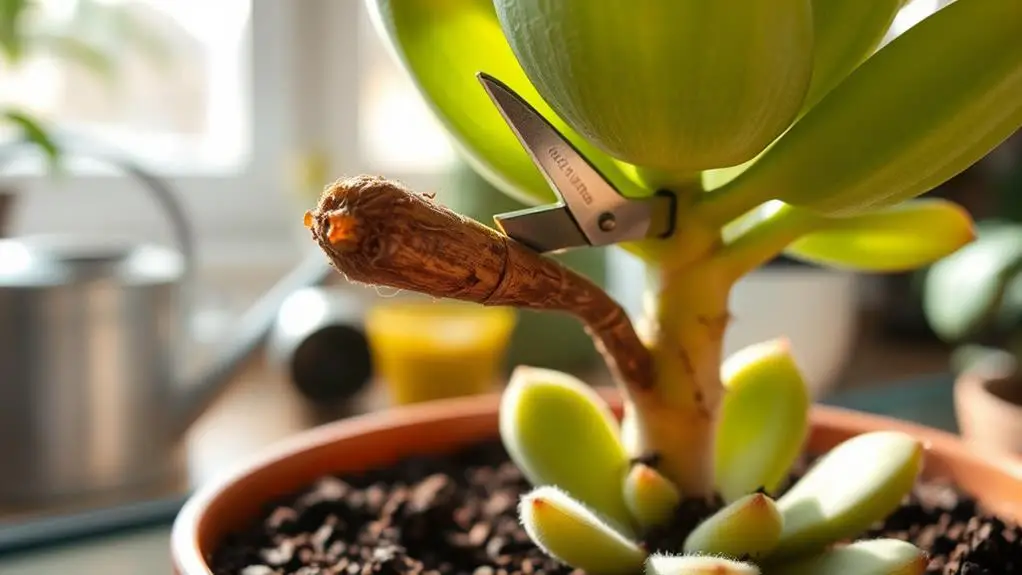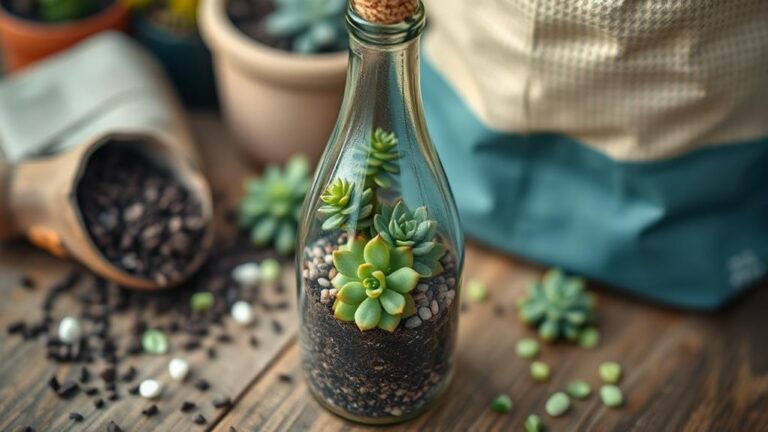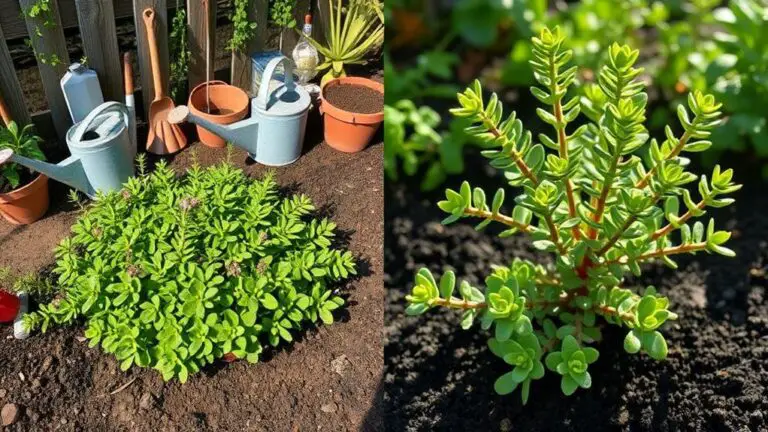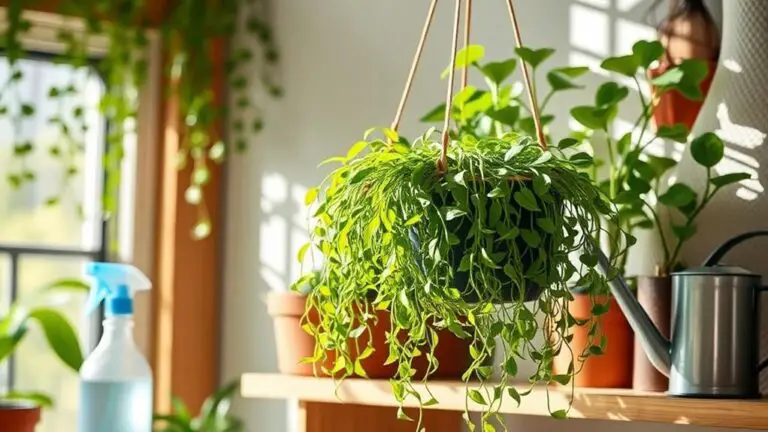How to Revive a Succulent With a Dried-Out Stem
When you discover a succulent with a dried-out stem, the first step is to check the plant's overall health and soil moisture. Is the stem soft or showing signs of rot? If so, you'll need to trim back to healthy tissue using clean scissors, but there's more you should know to guarantee your plant's recovery. How can you properly prepare the cut end and choose the right environment for replanting? Understanding these next essential steps can mean the difference between a thriving succulent and one that continues to struggle.
Assess the Plant's Health
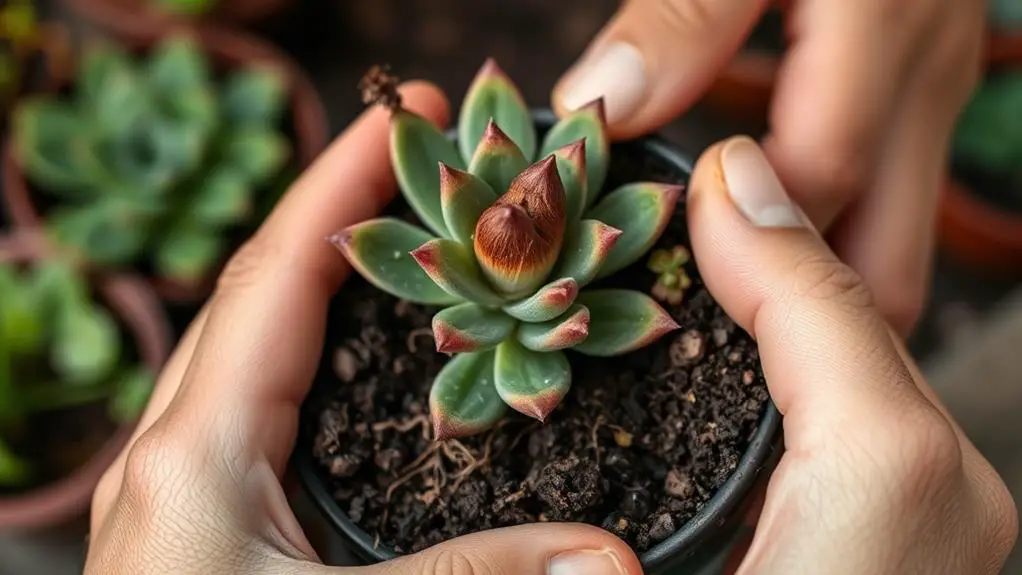
To revive a struggling succulent, the first step is to assess the plant's health thoroughly. Start by looking at the stem. If it's shriveled or appears dehydrated, your succulent needs urgent care. These signs and symptoms indicate that the plant might be lacking moisture.
Next, check the leaves. Are they browning or curling? These are also signs of dehydration, suggesting your succulent needs water.
Now, gently press the stem. If it feels soft or mushy instead of firm, it might be suffering from rot, not dehydration. This requires a different approach. To really understand what's happening, assess the soil moisture. Stick your finger into the soil up to a few inches. If it feels bone dry, your plant is likely underwatered and needs a good drink.
Look for dead or dying leaves at the base of your succulent. Removing these can help you better see the overall health and stress level of the plant.
Remove Dead Sections
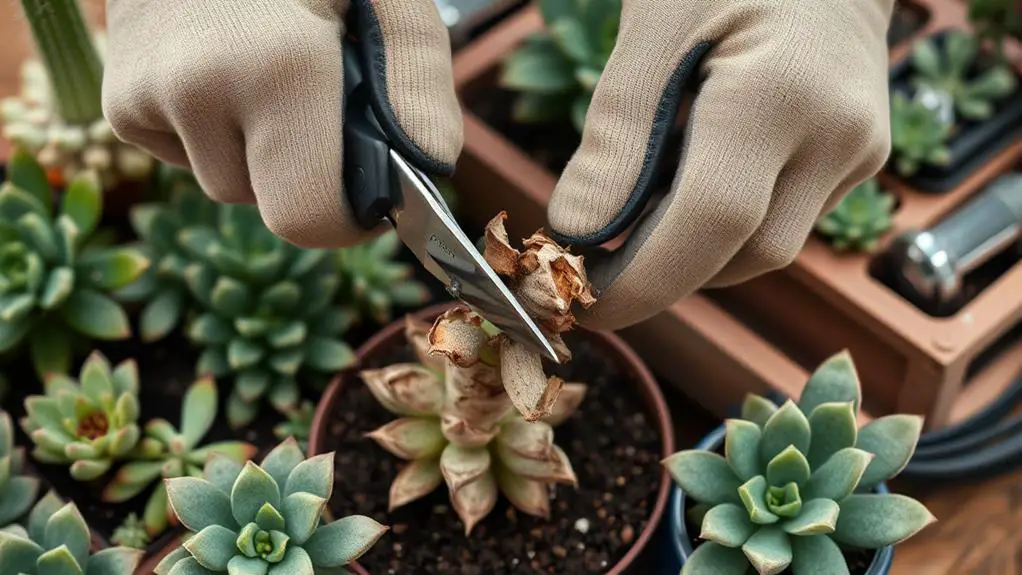
Begin by gently examining the succulent's stem to identify any dried-out or dead sections, which typically appear brown, shriveled, or mushy. Once you've spotted them, it's time to remove dead sections to help your plant thrive.
- Gather Tools: Use clean, sharp scissors or pruning shears.
- Identify Cut Points: Look for a healthy leaf node or where the stem is firm and green.
- Make the Cut: Carefully cut just above the healthy leaf node.
- Dispose Properly: Immediately throw away the dead sections to prevent disease spread.
When you cut, make certain the pruning shears are clean to avoid infecting the plant. After cutting, allow the cut areas to dry out and callous over. This process is essential for reducing the risk of rot when you water the succulent again.
Monitor your succulent closely after pruning. Confirm it gets adequate light and proper watering. This helps encourage new growth from the healthy parts of the stem.
Let the Ends Callous
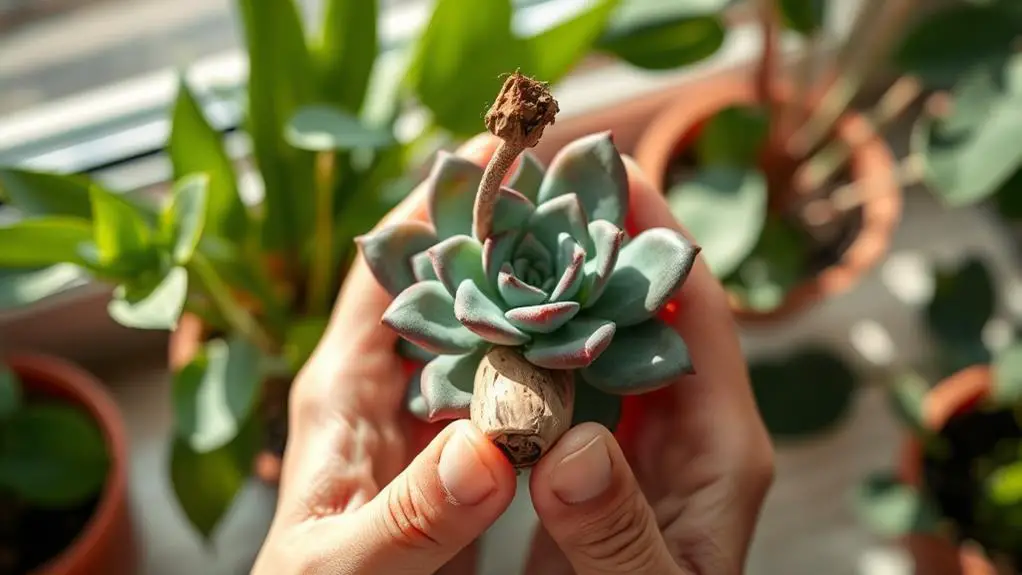
Allowing the ends of your succulent to callous is an important step in the revival process. When you cut a succulent's stem, it's vital to let the ends dry out and harden to prevent rot. This process, known as callousing, helps reduce moisture loss and creates a protective barrier against harmful pathogens.
To start, place the cut ends of your succulent in a dry, shaded area with good air circulation. This environment helps the tissue dry and harden effectively. Typically, letting the ends callous for 1 to 3 days is sufficient. If the stem is particularly damaged or soft, trim it back to healthy tissue before letting it callous.
During this period, the succulent's tissue will gradually dry out, forming a hard surface. This callous acts as a shield, preventing excess moisture from seeping in and causing rot when you replant the succulent.
Remember, patience is key here—rushing this step can lead to further issues.
Once the ends have calloused, you're ready for the next step. Replant your succulent in well-draining succulent soil to promote healthy root growth and recovery. Following these steps guarantees your succulent has the best chance to thrive again.
Choose the Right Soil
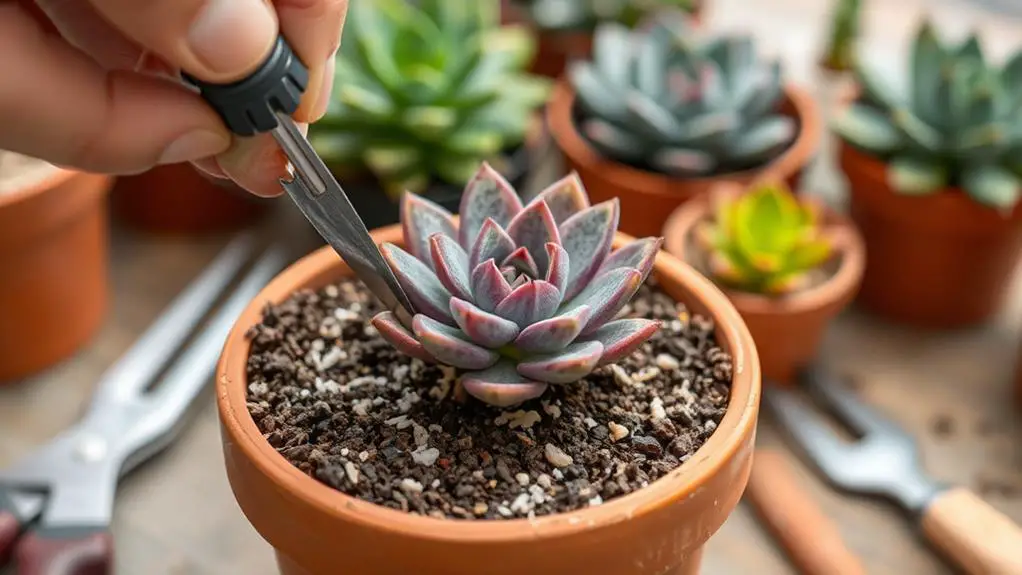
Once the ends of your succulent have calloused, the next significant step is selecting the right soil. Choosing a well-draining medium is essential to keep your succulent healthy and prevent further drying out of the stem. A good soil mix helps avoid excess moisture, which can cause root rot.
For the best results, follow this simple recipe for a potting mix:
- 2 parts potting soil: This provides the essential nutrients your succulent needs.
- 1 part perlite: This lightweight material improves drainage and aeration.
- 1 part coarse sand: It enhances the soil structure and prevents compaction.
You can also opt for specialized cactus and succulent soil mixes available at most garden centers. These mixes are designed to support the unique needs of succulents, promoting healthy growth and recovery.
When repotting a succulent, always use fresh soil. This eliminates any pathogens or pests that might've caused your plant's decline.
Make sure your pot has proper drainage holes to allow excess water to escape, ensuring the soil is completely dried between waterings. Regularly check the moisture level to keep your succulent happy and thriving.
With the right soil, you're well on your way to reviving your precious plant!
Replant the Succulent
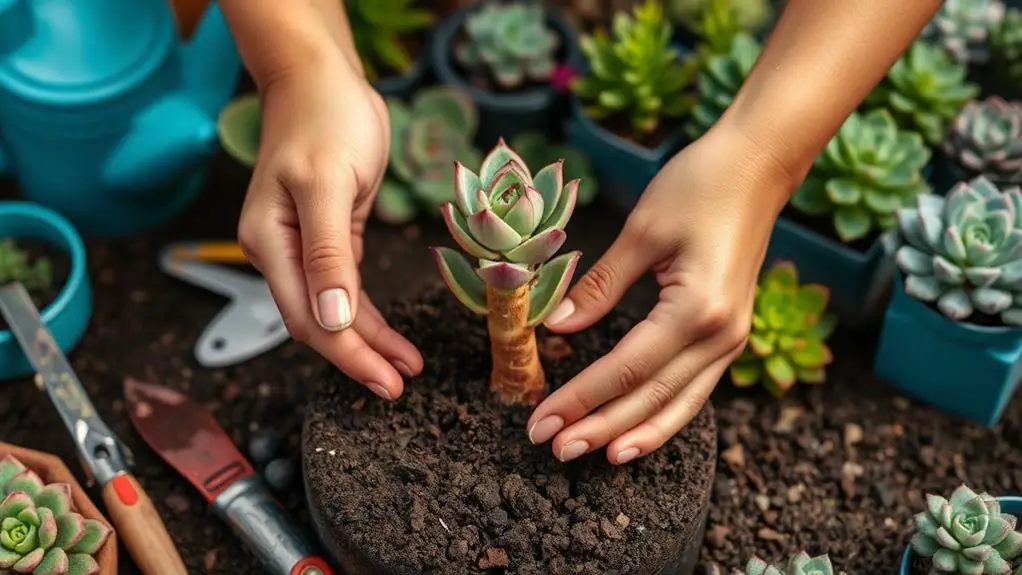
After preparing the right soil mix, it is vital to focus on replanting your succulent properly. Start by choosing a pot with drainage holes to prevent water from pooling, which can cause root rot. Fill the pot halfway with well-draining soil specifically designed for succulents. This soil mix will promote healthy root growth and prevent water retention.
Next, trim the dried-out or damaged stem of your succulent, making sure you cut above any signs of rot. This encourages new growth from a healthy section. Place the succulent in the center of the pot and gently fill in around it with more well-draining soil. Press the soil lightly to eliminate air pockets.
After replanting, it is important to water lightly. This helps the soil settle around the roots without overwhelming the plant. Finally, place your succulent in a spot with bright indirect sunlight. This location will support recovery and avoid potential sunburn.
| Step | Key Actions |
|---|---|
| Choose a Pot | Confirm it has drainage holes |
| Prepare Soil | Use well-draining soil |
| Planting | Trim stem, fill with soil |
| Watering | Water lightly |
| Sunlight | Bright indirect sunlight |
Following these steps will give your succulent the best chance to thrive and recover.
Water Sparingly
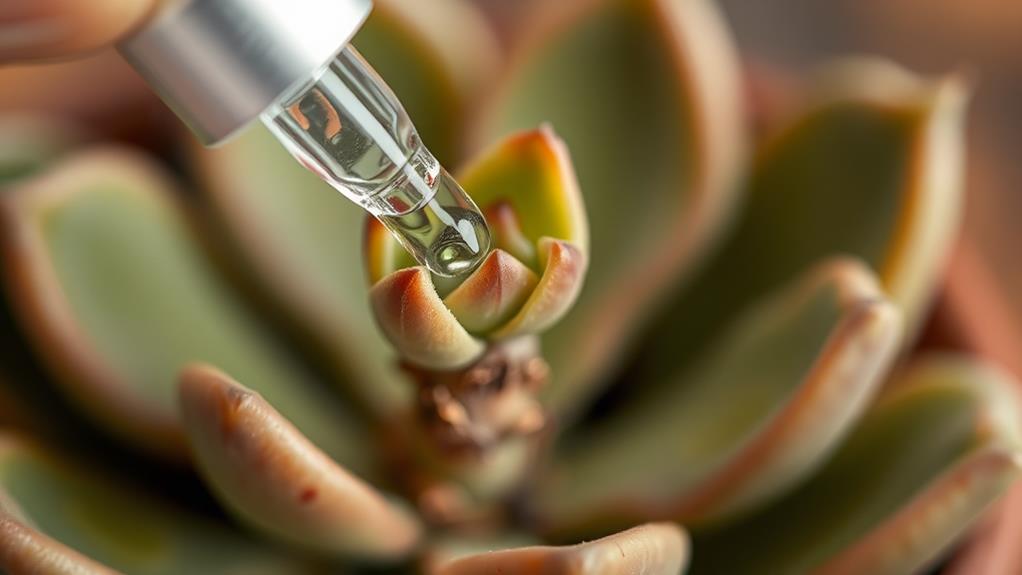
With your succulent properly replanted, it's time to focus on watering sparingly. Succulents are designed to thrive in dry conditions, so overwatering can quickly worsen a dried-out stem.
To get started, follow these steps:
- Assess the Soil: Check if the soil feels completely dry. If it does, add a small amount of water at the base of the plant.
- Water Gradually: Allow the succulent to absorb moisture slowly. This prevents shock and gives the plant time to adjust.
- Wait and Watch: After the initial watering, wait at least a week before checking the soil again. This helps avoid turning your plant into an over-watered succulent.
- Monitor for Recovery: Look for signs like plump leaves or new growth. These are positive indicators that the succulent needs are being met.
Ensure Proper Drainage
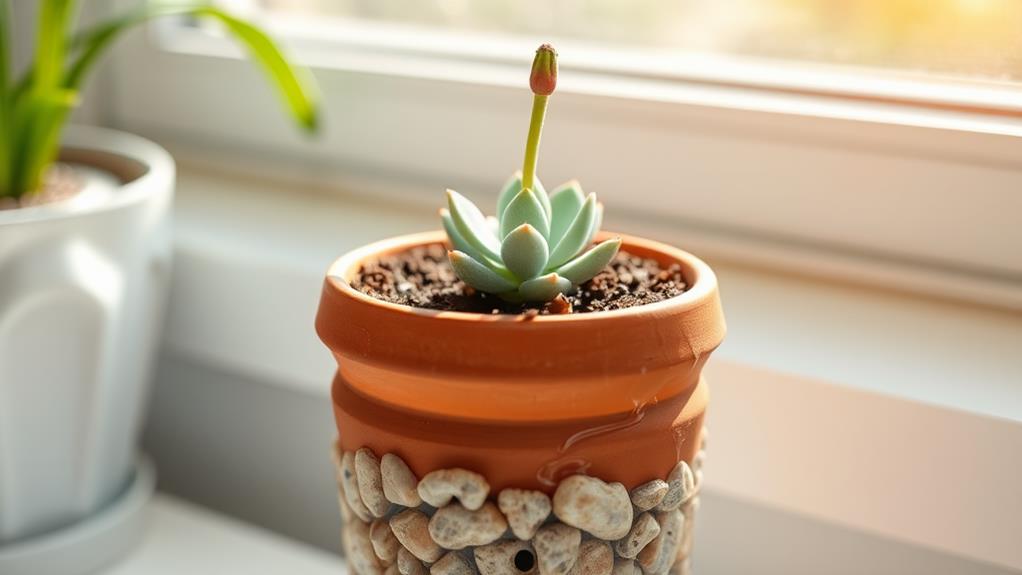
To guarantee your succulent thrives, choose a pot with drainage holes to let excess water escape and prevent root rot.
Use well-draining soil, like one mixed with perlite or pumice, to help water flow through easily and keep the roots healthy.
If the soil feels compacted, repot your succulent into fresh soil to boost airflow and moisture control.
Choose Suitable Pot
Selecting the right pot for your succulent is essential to its health and vibrancy. To guarantee your succulent thrives, you'll need to focus on a few key factors when choosing a pot.
First, always opt for a pot with drainage holes. These holes allow excess water to escape, preventing root rot and promoting healthy root growth.
Next, consider the material of the pot. Breathable materials like terracotta or ceramic are excellent choices. They help regulate moisture levels better than plastic pots, ensuring your succulent doesn't sit in soggy soil.
Here's a handy guide to help you:
- Pot Size: Choose a pot that fits the succulent's root system without being too large. Oversized pots retain too much water.
- Drainage Holes: Ensure the pot has drainage holes to let excess water escape.
- Material: Opt for breathable materials like terracotta or ceramic.
- Saucer: Use a pot with a saucer to catch excess water, but remember to empty it regularly.
Lastly, keep an eye on the soil's moisture levels. If it stays soggy for too long, it might be time to repot your succulent into a more suitable container.
Use Well-Draining Soil
Proper soil selection is absolutely essential when reviving a succulent. You need well-draining soil to allow excess moisture to escape, which prevents root rot and promotes healthy succulent growth. A mix specifically designed for succulents often contains materials like perlite, pumice, or coarse sand. These components enhance the soil's drainage capabilities, ensuring your plant's roots stay dry and healthy.
When repotting your succulent, choose a pot with drainage holes. These holes let water escape, reducing the risk of water accumulation at the roots. To check the soil's drainage efficiency, observe how quickly water flows through. If water sits on top for too long, it's a sign that the soil isn't draining well enough. Regularly monitoring this can help maintain the ideal conditions your succulent needs to thrive.
Repotting your succulent into fresh, well-draining soil can greatly aid its recovery, especially if it had a dried-out stem due to poor soil conditions before.
Provide Indirect Sunlight
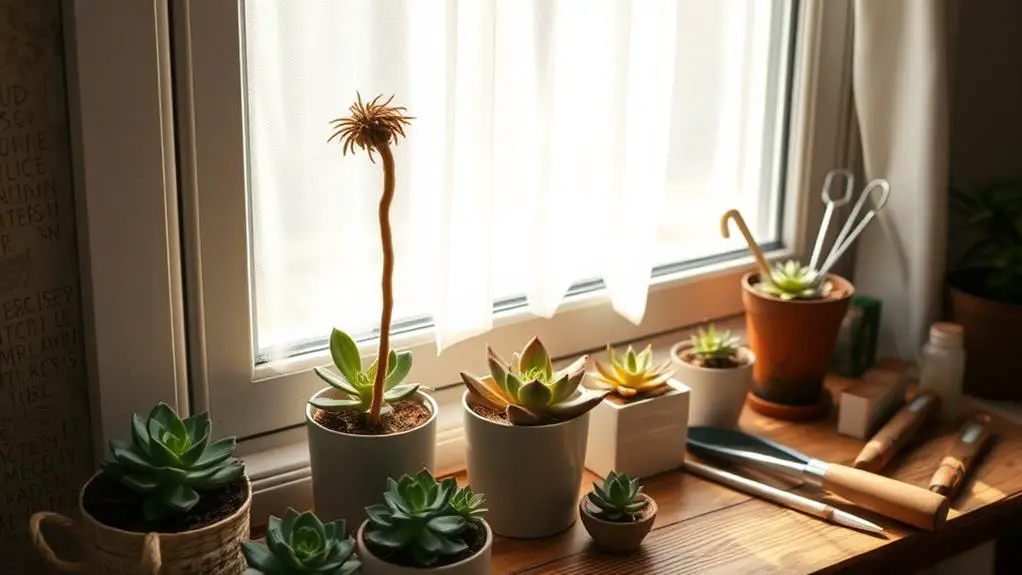
A crucial step in reviving a succulent is guaranteeing it gets indirect sunlight. Providing indirect sunlight helps prevent further stress on the plant and allows it to recover without the risk of sunburn or additional dehydration.
Succulents thrive in bright, indirect light conditions, which mimic their natural habitats, promoting healthier growth and revitalization.
To help your succulent recover, follow these steps:
- Position near a window: Place your succulent near a window with filtered light. Using sheer curtains can reduce direct sunlight exposure while still offering ample brightness.
- Rotate regularly: Regularly rotate the plant to guarantee even exposure to light. This promotes balanced growth and can help with the recovery of any dried-out stems.
- Monitor the succulent: Keep an eye on your succulent for signs of improvement. Look for plumping of the stems or new growth, which indicates that the indirect sunlight is aiding in its revival process.
- Avoid direct sunlight: Direct sunlight can cause sunburn and further dehydration. Guarantee the light is always indirect to avoid additional stress on the plant.
Monitor for Pests
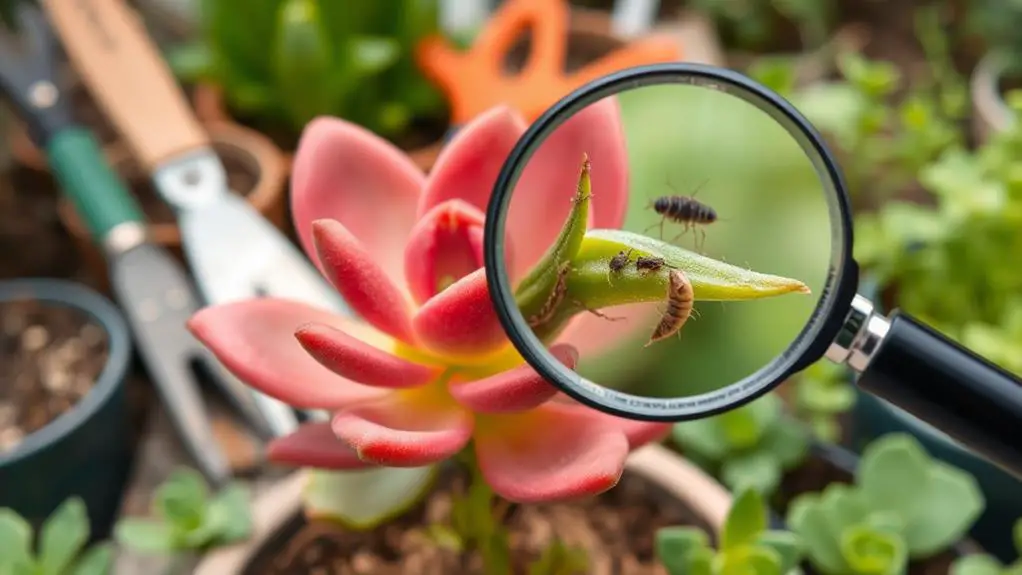
Regularly inspecting your succulent for pests is essential to its revival process. You need to keep an eye out for common pests like mealybugs, spider mites, and scale. These pests can damage the stems and leaves of your plant.
Look for signs of infestation such as webbing, sticky residue, or visible bugs. By catching these problems early, you can save your succulent from further damage.
If you find any pests, isolate the infested plant immediately. This prevents the pests from spreading to your other healthy succulents.
Once isolated, treat the affected areas with insecticidal soap or neem oil. Make sure to apply these treatments thoroughly, covering every part of the plant to guarantee complete coverage.
After treating your succulent, monitor it weekly for any new pest generations. Sometimes, pests can return, so you might need to repeat the treatment.
Keep a close watch and act quickly if you see any new signs of pests. This consistent monitoring and treatment will help ensure that your succulent revives and thrives.
Maintain Regular Care

Ensuring your succulent receives consistent care is essential for its revival. Regular care involves a few key practices to keep your plant healthy and thriving.
First, you need to monitor soil moisture levels. Succulents don't like to be over-watered or under-watered. Here's a simple approach to maintain regular care:
- Water sparingly: Establish a schedule where you allow the soil to dry completely between waterings. This usually means watering every two to three weeks, but adjust based on your succulent's needs.
- Check soil moisture: Regularly check the soil to avoid sogginess. You can stick your finger about an inch into the soil; if it feels dry, it's time to water.
- Provide indirect light: Place your succulent in a spot with bright, indirect light. Direct sunlight can stress your plant and cause the stems to dry out even more.
- Weekly inspections: Look over your succulent every week for signs of distress, like discoloration or wilting. This helps you catch problems early and adjust your care routine.
With these steps, your succulent will have a better chance to bounce back and grow strong.
Keep an eye on it, and it'll reward you with its resilient beauty!
Frequently Asked Questions
Can Dried Out Succulents Be Revived?
Yes, you can often revive dried-out succulents. Check if the stem is firm; if it is, rehydrate the soil thoroughly. Watch for new growth. If the stem is brittle, try propagating from healthy leaves or segments.
Why Is My Succulent Stem Dried Out?
Your succulent's stem is dried out due to prolonged underwatering, extreme temperatures, or low humidity. Overexposure to sunlight, poor soil quality, or pests can also damage the roots, preventing proper hydration and causing the stem to dry out.
Can a Succulent Grow Back From a Stem?
Yes, your succulent can grow back from a healthy stem. Cut just above a viable node, let the end callous for a few days, then plant it in well-draining soil. Water sparingly until new growth appears.
Can You Save a Succulent With Stem Rot?
Yes, you can save a succulent with stem rot. Remove it from its pot, trim away the rot, and let it dry. Repot in fresh, well-draining soil, guarantee proper drainage, and place in bright, indirect sunlight.
Conclusion
Reviving your succulent might seem tough, but with a little care, you can do it! Just remember to check its health, trim any dead parts, and let the ends callous. When you replant, use well-draining soil and water lightly. Keep your plant in bright, indirect sunlight and watch for pests. With patience and regular care, your succulent will bounce back. You've got this, and your plant will thank you for the love and attention!

